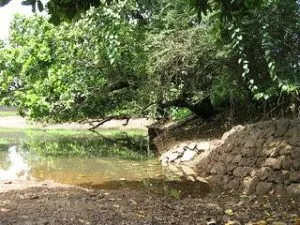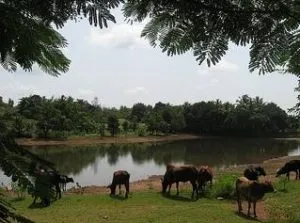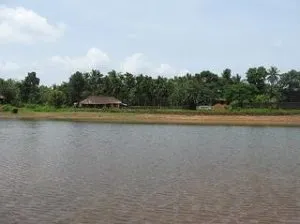Lessons from Kerala and Karnataka's lesser-known rainwater harvesting methods
Borewells are temporary, highly exploitative, and unsustainable means of procuring water.
Madakas are one of the fast disappearing traditional rainwater harvesting structures found in the laterite belts of Karnataka and Kerala. They are naturally occurring depressions with high terrain on the three sides where water from the surrounding laterite slopes, mainly run-off from the rains, is accumulated. These have been traditionally used to harvest rainwater by constructing bunds on the open fourth side of the depression to check this run-off from the slopes.
However, there is no documentation and information available on madakas, informs Shree Padre who points at the urgent need to make efforts at restoring and reviving these traditional structures which can provide sustainable solutions to the water scarcity problems that farmers have been facing in recent years.

A glimpse of the beautiful village of Padre located in Kasargod district makes it very difficult to believe that this is the place where the endosulfan tragedy continues to leave its imprints. We have come to visit Shree Padre, better known as the rain water man for his pioneering work on farm journalism and documentation of traditional water harvesting methods for water conservation, who continues to live in the village and works on sensitising the communities on issues very close to the heart of the farmers. These include water conservation through revival of traditional water harvesting methods, documenting and sharing old and new methods, success stories by farmers on water harvesting, and developing and propagating agricultural products for markets such as jackfruit. Besides this, he continues to direct attention and sensitise communities from Kerala and Karnataka on the endosulfan issue.
The madakas from Karnataka and Kerala

We go to visit the village Bedramballa to look at the traditional rainwater harvesting structures known as the madakas which have traditionally been used for supplementary irrigation of rice fields for a long time. Madakas are the most common traditional rainwater harvesting structures used mainly in the laterite belt districts of Dakshina Kannada and Kasargod in Karnataka and Kerala respectively. They are naturally occurring depressions with high terrain on the three sides where water from the surrounding laterite slopes, mainly runoff from the rains, gets accumulated. Traditionally, bunds are constructed on the open fourth side of this depression to check this runoff from the slopes and harvest rainwater.
The laterite soil in agricultural areas is ideal for madakas as laterite belts have faster absorption and depletion of water. Madakas aid in the slow percolation of water through cracks and are thus often compared to percolation ponds. This helps in the recharge of groundwater and water oozes through springs and other outlets into man-made tanks or wells which are located near the point of water collection in the madaka.

The main function of a madaka is thus to catch most of the run-off that flows from their catchment in the higher elevations. Besides storage of water for six to seven months, the madakas can dry up in summer but can help immensely by raising the water table of the aquifers below. Building the madaka higher up ensures water in the lower areas until the end of summer. The excess of flow over the bunds can be utilised to irrigate the fields. Madakas are most commonly used for irrigation, but their other function of absorbing water for recharge continues to be a relatively lesser-known feature till recent times.
Care has to be taken to see that the first rains do not flow into the madaka as they bring along with them leaves and silt from the slopes that can clog the cracks in the madaka bed, reducing percolation and also the storage capacity of the madaka. Afforestation is also important to prevent silt deposits from accumulating in the madakas. Besides their use as water storage structures for irrigation and percolation for groundwater recharge, madakas also help by creating a new ecosystem that shelters animals and birds and helps in reviving aquatic life.
Our visit to Bedramballa village

We come up across a madaka which looks like a pond or lake like structure or water accumulation, surrounded by natural slopes on three sides and constructed bunds on one side made up of rocks. It makes a serene and peaceful picture with the surrounding green vegetation and the view of the occasional cattle that venture into the water to quench their thirst. We also meet a few villagers sitting under the shades of the trees and rocks around the Madakas. We talk to two villagers Mr Govind and Mr Jagannath, who inform us that this is a very old madaka and that madakas have been useful for irrigation for rice. They also tell us that now very less rice is grown but still this water is useful for public use and can serve as drinking water for animals and cattle.
There is no documentation and information available on the madakas, informs Shree Padre. Madakas continue to be abandoned and replaced by borewells, a temporary, highly exploitative, and unsustainable means of procuring water. This calls for an urgent need to make efforts at restoring, reviving, and creating awareness regarding this traditional wisdom and knowledge that people have, lest it fast disappears, taking along with it the age-old wisdom of our ancestors to live in harmony with nature, not by plundering it, but by treating it with respect and reverence, he argues. The villagers inform us that Madakas are fast disappearing and are known only to the elderly in the village.
Disclaimer: This article, authored by Aarti Kelkar-Khambete, was first published in India Water Portal.







